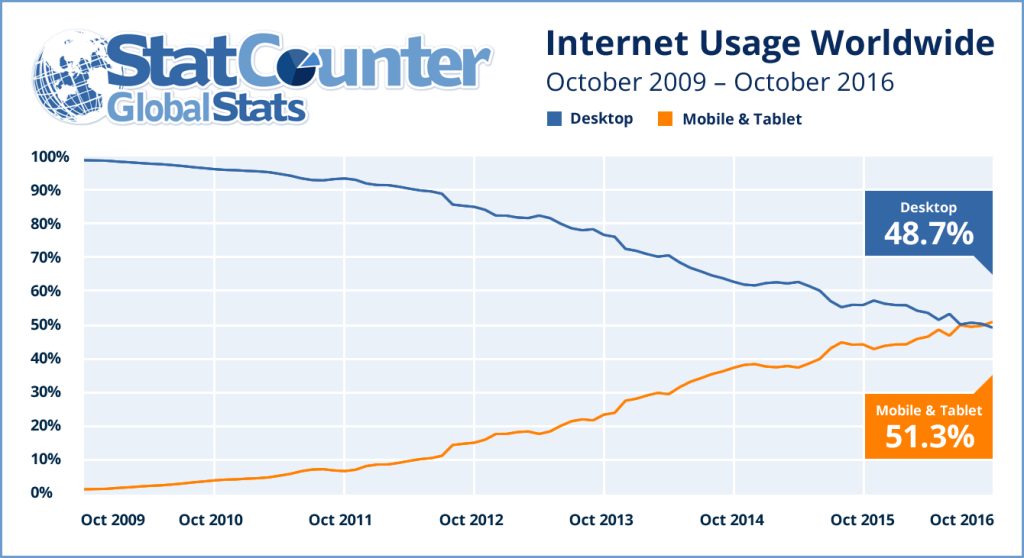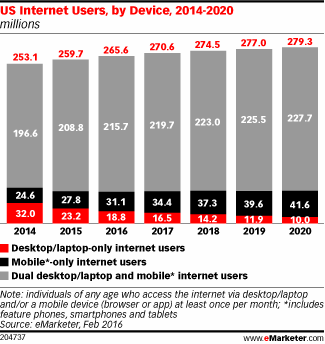If there are any certainties, it is that "everyone" agrees internet access, and faster access, are good things that "everybody" should have. That typically means "most people" approve of measures to improve access and speeds in rural areas and for poorer people.
One recent example: Tennessee Gov. Bill Haslam has signed the Tennessee Broadband Accessibility Act into law, releasing $45 million, to be disbursed over the next three years, in the form of grants and tax credits for Internet Service Providers (ISPs) making broadband service available to unserved homes and businesses.
 |
| source: StatCounter |
Connected Nation says the plan allows Tennessee’s private, non-profit electric cooperatives to provide retail broadband service and make grant funding available to the state’s local libraries to help residents improve their digital literacy skills.
Observers can applaud the new efforts, while also noting that consumer preferences appear to be changing. It appears that virtually all the growth in broadband usage since about 2013 has come either from mobile or some other method of gaining access, based on a reported decline in home internet access purchasing since 2013.
There was a seven percent net gain in internet usage between 2013 and 2014, even as fixed network access dropped two percent. That suggests consumers are opting increasingly to use the internet significantly or primarily on their mobiles.
In the U.S. market, about 12 percent of all internet users relied solely on mobile only for internet access.
About six percent of Tennessee homes are unserved, studies have concluded. The bigger problem is the percentage of homes that do not have access at speeds at least 25 Mbps.
Perhaps 17 percent of Tennessee homes apparently did not have 25 Mbps access in 2014, while 66 percent did have such access.
Fixed network adoption in Tennessee seems to have peaked about 2013, even as internet access adoption climbed to 81 percent.
That trend, reported in other earlier studies, suggests that mobile internet now is what is driving incremental subscription growth.
A related trend--faster speeds--could also affect our statistics. Some access lines using digital subscriber line could shift to fixed wireless as Verizon and AT&T turn to fixed wireless, including 5G variants, to boost access speeds.
How those lines are counted also could affect fixed access adoption figures. There is a logic to counting a fixed wireless connection as a "fixed" connection. There also is a logic to counting it as a "mobile" connection, if supplied by a mobile operator's network.
The point is that all things related to use of the internet, its apps and devices change with time. It almost does not make sense to distinguish between "broadband" access and ""internet access." It no longer makes sense to ignore the huge amount of internet access that happens in the mobile domain.
Nor, where it comes to measuring "broadband" or "internet access" progress, can be ignore the role played by mobile internet access.
A related trend--faster speeds--could also affect our statistics. Some access lines using digital subscriber line could shift to fixed wireless as Verizon and AT&T turn to fixed wireless, including 5G variants, to boost access speeds.
How those lines are counted also could affect fixed access adoption figures. There is a logic to counting a fixed wireless connection as a "fixed" connection. There also is a logic to counting it as a "mobile" connection, if supplied by a mobile operator's network.
The point is that all things related to use of the internet, its apps and devices change with time. It almost does not make sense to distinguish between "broadband" access and ""internet access." It no longer makes sense to ignore the huge amount of internet access that happens in the mobile domain.
Nor, where it comes to measuring "broadband" or "internet access" progress, can be ignore the role played by mobile internet access.


No comments:
Post a Comment